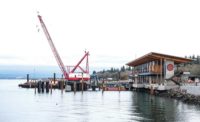The use of prefabricated and preassembled building components isn’t the newest trend in construction. Many specialty trades and homebuilders have applied prefab practices for decades. But with contractors of all stripes increasingly pressed to safely meet the competing demands of productivity and quality with fewer people and, often, even tighter schedules, it’s hard to find a delivery method better suited for the times.
Evidence of this trend can be found in the number of contractors investing in off-site facilities where many field-based construction tasks can be consolidated and performed in safer production-line environments.
Chicago-based Skender, for example, is fitting up a 105,000-sq-ft facility for crafting volumetric modular-building components that the company plans to have in full-scale operation by March. Pete Murray, Skender’s president of manufacturing, calls the facility “a blank slate,” customized to handle production of large modules “at the speed and volume we want to do.”
RK Mission Critical, the modular-construction arm of Denver-based RK Mechanical, is about to move into a new 300,000-sq-ft production-oriented facility that will complement its two off-site prefab centers.
At the other end of the spectrum, Duro Electric Co., an Englewood, Colo., electrical contractor, only recently ventured into off-site prefab following an ownership change late last year. Carved from the firm’s work and warehouse space, the 12,000-sq-ft area houses production of in-wall and ceiling electrical circuits, panel boards and other assemblies done by a six-person staff.
While the size and scale of off-site prefab operations vary, based on a contractor’s specific capabilities and market ambitions, the facility where that work will take place requires significant planning to realize those economic and efficiency outcomes. Many contractors have drawn expertise from the manufacturing and process sectors, while others are utilizing their own instincts and experience to bring field tasks indoors, often incorporating lean construction principles along the way.
Volume Is Key
Any investment in off-site prefab won’t be successful without solid planning and research. The most fundamental factor is that the move to off-site operations must make economic sense. Volume is the key, says Jeff Knoup, vice president of Mechanical Inc., Freeport, Ill., which operates three prefab shops for piping and sheet metal. “Otherwise, you won’t be effective.”
Some attributes of an off-site prefab facility might seem obvious—utilities to power equipment, ample staging for materials and storing components, inventory-tracking tools and so forth. But that’s just the start.
“It doesn’t do any good to build a system as if you’re doing same thing in the field.”
– John Marrinucci, General Manager, RK Mission Critical
“It doesn’t do any good to build a system as if you’re doing same thing in the field,” notes RK Mission Critical General Manager John Marrinucci. “It’s important to know the process from the start in order to figure out how to make it more efficient.”
For example, laydown space becomes more precious as the number of concurrent jobs increases.
“Accommodating the flow of activity is becoming more important as schedules become shorter,” adds Mark Jonson, who leads the construction business line for Seattle-based specialty contractor McKinstry.
Although standardization of materials and products contributes to efficiency gains in off-site prefab, contractors must incorporate flexibility as well. All of Duro Electric’s work tables are on wheels, while the majority of its larger equipment can be reconfigured as needed.
“That helps us adjust as work changes, or if we need to make special one-off products,” says Mark Stark, Duro’s vice president of operations.
On the other hand, spacing between equipment and work stations must be optimized to balance elbow room with process efficiency. “Steps matter,” explains Knoup. “Too much distance lowers productivity.”
Integrating design capabilities with prefab operations poses another proximity issue for off-site facilities. That was one of the first lessons Golden Construction Co., Birmingham, Ala., learned after its merger earlier this year with local design firm Appleseed Workshop, resulting in a rebranded organization called Creature.
“With such a massive amount of collaboration and innovation going on, there needs to be a direct path to design capability,” says CEO Geoff Golden. While Creature will use Golden Construction’s prefab space for now, “making spaces more open and interactive will be a big consideration going forward,” he says.
Distance considerations reach a macro scale when considering where to locate off-site prefab. As distance between shops and jobsites increase, so do shipping costs. “Too far, and you’ll wipe out any production-efficiency savings,” says Eric Lamb, executive vice president, who leads preconstruction for DPR Construction, Redwood City, Calif.
Even then, there might be other factors. Though efficiently serving its Chicago-area clients was critical for Skender’s new facility, so too was the union shop’s commitment to the city’s labor force. The company’s site search pinpointed a location in a building near I-55.
“It’s 10 minutes from downtown and convenient to areas where we expect there to be a significant number of multifamily housing opportunities,” Murray says.
A Tech-Based Foundation
Not surprisingly, technology is also critical to supporting successful off-site prefab. Mechanical Inc. is among the firms that utilize FabPro tracking software to gauge productivity for tasks such as welds per diameter inch of piping, or welds per linear inch of structural steel.
Other contractors use proprietary software to better manage off-site operations and their products. McKinstry, for example, is beefing up its modeling system to track every component through its life cycle. “You’re not reinventing the same information several times,” Jonson says. “Plus, you’re developing data that the owner can use once the project is complete.”
Small wonder, then, that Lamb considers “a deep skill set in technology” essential to off-site prefab operation. And not just on the manufacturing side. “You need technology to tightly control installation, particularly when coordinating with various trades,” he says.
Off-site prefab is not solely about laying out facilities or selecting equipment and software. A host of people issues must be addressed. Stark says field personnel often resist off-site prefab, fearing their jobs are at risk.
“You need to convince them that prefabrication is helping them get more work, not taking it away,” he says, adding that Duro relied on several key field superintendents to help plan off-site processes. They helped fine-tune activities and work flow. Stark says “their perspective helped build acceptance among our field staff.”
More difficult may be preserving relationships with trades. Golden reports breaking with subs unwilling to adapt, while others receive more work for embracing the new approach. “There’s no way to avoid being the ‘bad guy’ to a firm unwilling to be flexible,” he says.
Getting an off-site prefab operation up and running may be cause for celebration, but the job is just beginning. Projects and their needs change, as do tools and technologies for manufacturing. This requires contractors to be on the watch for new techniques that can make a good operation even better.
For example, Mechanical Inc. aspires to eliminate pencils, paper and tape measures from prefab tasks. “All are inefficient and unreliable, which slows work and opens the door to mistakes,” Knoup says.
The company also is testing emerging technologies to advance efficiencies even further. Such an approach, Knoup adds, “pushes you to broaden your thinking and consider doing things in ways that you never thought about.”






